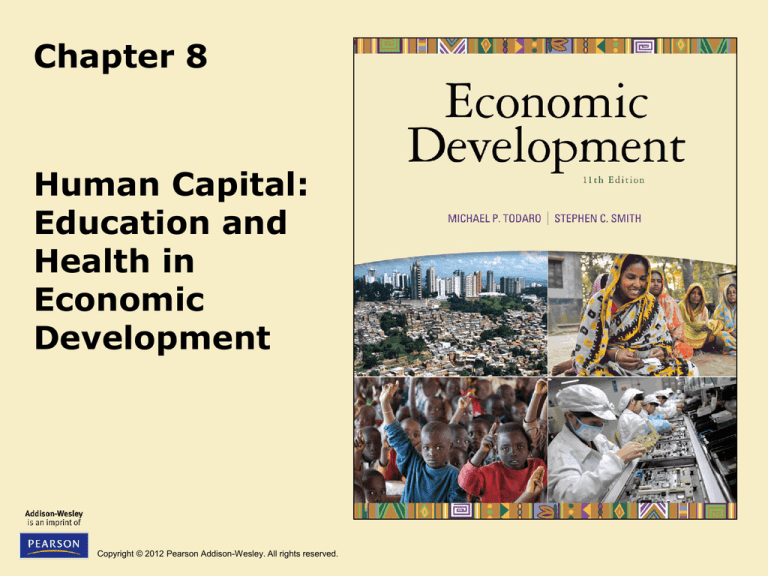
Chapter 8
Human Capital:
Education and
Health in
Economic
Development
Copyright © 2012 Pearson Addison-Wesley. All rights reserved.
8.1 The Central Roles of Education
and Health
• Health and education are important
objectives of development, as reflected in
Amartya Sen’s capability approach, and in
the core values of economic development
• Health and education are also important
components of growth and development –
inputs in the aggregate production
function
Copyright © 2012 Pearson Addison-Wesley. All rights reserved.
8-2
Education and Health as Joint
Investments for Development
• These are investments in the same individual
• Greater health capital may improve the returns to
investments in education
– Health is a factor in school attendance
– Healthier students learn more effectively
– A longer life raises the rate of return to education
– Healthier people have lower depreciation of education
capital
• Greater education capital may improve the returns to
investments in health
– Public health programs need knowledge learned in school
– Basic hygiene and sanitation may be taught in school
– Education needed in training of health personnel
Copyright © 2012 Pearson Addison-Wesley. All rights reserved.
8-3
Improving Health and Education: Why
Increasing Incomes Is Not Sufficient
• Increases in income often do not lead to
substantial increases in investment in
children’s education and health
• But better educated mothers tend to have
healthier children at any income level
• Significant market failures in education
and health require policy action
Copyright © 2012 Pearson Addison-Wesley. All rights reserved.
8-4
8.2 Investing in Education and Health:
The Human Capital Approach
• Initial investments in health or education
lead to a stream of higher future income
• The present discounted value of this
stream of future income is compared to
the costs of the investment
• Private returns to education are high, and
may be higher than social returns,
especially at higher educational levels
Copyright © 2012 Pearson Addison-Wesley. All rights reserved.
8-5
Figure 8.1 Age-Earnings Profiles by Level of
Education: Venezuela
Copyright © 2012 Pearson Addison-Wesley. All rights reserved.
8-6
Figure 8.2 Financial Trade-Offs in the
Decision to Continue in School
Copyright © 2012 Pearson Addison-Wesley. All rights reserved.
8-7
Table 8.1 Sample Rates of Return to Investment in
Education by Level of Education, Country, Type, and
Region
Copyright © 2012 Pearson Addison-Wesley. All rights reserved.
8-8
8.3 Child Labor
• Child labor is a widespread phenomenon
• The problem may be modeled using the
“multiple equilibria” approach
• Government intervention may be called for
to move to a ‘better’ equilibrium
• Sometimes this shift can be self-enforcing,
so active intervention is only needed at
first
Copyright © 2012 Pearson Addison-Wesley. All rights reserved.
8-9
Assumptions of the Child Labor
Multiple Equilibria Model
• Luxury Axiom: A household with
sufficiently high income would not send its
children to work
• Substitution Axiom: Adult and child labor
are substitutes (perfect substitutes in this
model), in which the quantity of output by
a child is a given fraction of that of an
adult: QC = γQA, 0 < γ < 1.
Copyright © 2012 Pearson Addison-Wesley. All rights reserved.
8-10
Figure 8.3 Child Labor as a Bad Equilibrium
Copyright © 2012 Pearson Addison-Wesley. All rights reserved.
8-11
Other approaches to child labor
policy
• Get more children into school (as in Millennium Development
Goals), e.g. new village schools; and enrollment incentives for
parents such as in Progresa/ Oportunidades
• Consider child labor an expression of poverty, so emphasize ending
poverty generally (a traditional World Bank approach, now
modified)
• If child labor is inevitable in the short run, regulate it to prevent
abuse and provide support services for working children (UNICEF
approach)
• Ban child labor; or if impossible, ban child labor in its most abusive
forms (ILO strategy; “Worst Forms of Child Labor Convention”)
• Activist approach: trade sanctions. Concerns: could backfire when
children shift to informal sector; and if modern sector growth slows
Copyright © 2012 Pearson Addison-Wesley. All rights reserved.
8-12
8.4 The Gender Gap: Discrimination
in Education and Health
• Young females receive less education than young males in
nearly every low and lower-middle income developing
country
• Closing the educational gender gap is important because:
– The social rate of return on women’s education is higher
than that of men in developing countries
– Education for women increases productivity, lowers
fertility
– Educated mothers have a multiplier impact on future
generations
– Education can break the vicious cycle of poverty and
inadequate schooling for women
– Good news: Millennium Development Goals on parity
being approached, progress in every developing region
Copyright © 2012 Pearson Addison-Wesley. All rights reserved.
8-13
Figure 8.4 Youth Literacy Rate, 2008
Copyright © 2012 Pearson Addison-Wesley. All rights reserved.
8-14
8.4 The Gender Gap: Discrimination in
Education and Health (cont’d)
• Consequences of gender bias in health and
education
– Economic incentives and their cultural setting
– “Missing Women” mystery in Asia
• Increase in family income does not always
lead to better health and education
Copyright © 2012 Pearson Addison-Wesley. All rights reserved.
8-15
Figure 8.5 Female-Male Ratios in Total Population in
Selected Communities
Copyright © 2012 Pearson Addison-Wesley. All rights reserved.
8-16
8.5 Educational Systems and
Development
• The Political Economy of Educational
Supply and Demand: The Relationship
between Employment Opportunities and
Educational Demands
• Social versus Private Benefits and Costs
Copyright © 2012 Pearson Addison-Wesley. All rights reserved.
8-17
Figure 8.6 Private
versus Social
Benefits and Costs
of Education: An
Illustration
Copyright © 2012 Pearson Addison-Wesley. All rights reserved.
8-18
8.5 Educational Systems and
Development
• Distribution of Education
– Lorenz curves for the distribution of education
• Education, Inequality, and Poverty
Copyright © 2012 Pearson Addison-Wesley. All rights reserved.
8-19
Figure 8.7 Lorenz Curves for Education in India and
South Korea
Copyright © 2012 Pearson Addison-Wesley. All rights reserved.
8-20
Figure 8.8 Gini Coefficients for Education in
85 Countries
Copyright © 2012 Pearson Addison-Wesley. All rights reserved.
8-21
8.5 Educational Systems and
Development (cont’d)
• Educational supply and demand: the relationship
between employment opportunities and
educational demands
• Social versus private benefits and costs
• Distribution of education
• Education, inequality, and poverty
• Education, Internal Migration, and the Brain Drain
Copyright © 2012 Pearson Addison-Wesley. All rights reserved.
8-22
8.6 Health Measurement and
Distribution
• World Health Organization (WHO): The key
United Nations agency concerned with
global health matters.
Copyright © 2012 Pearson Addison-Wesley. All rights reserved.
8-23
Figure 8.9 Life Expectancy in Various World
Regions
Copyright © 2012 Pearson Addison-Wesley. All rights reserved.
8-24
Figure 8.10 Under-5 Mortality Rates in
Various World Regions
Copyright © 2012 Pearson Addison-Wesley. All rights reserved.
8-25
Figure 8.11 Deaths of Children under
Age 5
Copyright © 2012 Pearson Addison-Wesley. All rights reserved.
8-26
Figure 8.12A Children’s Likelihood to Die in Selected
Countries
Copyright © 2012 Pearson Addison-Wesley. All rights reserved.
8-27
Figure 8.12B Proportion of Under-Five Children Who
Are Underweight, by Household Wealth, around 2008
Copyright © 2012 Pearson Addison-Wesley. All rights reserved.
8-28
8.7 Disease Burden
• HIV/AIDS
• Malaria
• Parasitic Worms and Other “Neglected
Tropical Diseases”
Copyright © 2012 Pearson Addison-Wesley. All rights reserved.
8-29
Figure 8.13 Proportion of Children under 5 Who Are
Underweight, 1990 and 2005
Copyright © 2012 Pearson Addison-Wesley. All rights reserved.
8-30
Table 8.2 Regional HIV and AIDS Statistics,
2009
Copyright © 2012 Pearson Addison-Wesley. All rights reserved.
8-31
Table 8.3 The Major Neglected Tropical Diseases,
Ranked by Prevalence
Copyright © 2012 Pearson Addison-Wesley. All rights reserved.
8-32
8.8 Health, Productivity, and Policy
• Productivity
– Is there a connection?
• Health Systems Policy
– Great variability in the performance of health
systems at each income level
Copyright © 2012 Pearson Addison-Wesley. All rights reserved.
8-33
Figure 8.14 Wages, Education, and Height of Males
in Brazil and the United States
Copyright © 2012 Pearson Addison-Wesley. All rights reserved.
8-34
Figure 8.15 GNI Per Capita and Life Expectancy at
Birth, 2002
Copyright © 2012 Pearson Addison-Wesley. All rights reserved.
8-35
Concepts for Review
• Acquired immunodeficiency
syndrome (AIDS)
• Basic education
• Brain drain
• Conditional cash transfer
(CCT) programs
• Derived demand
• Discount rate
• Educational certification
• Educational gender gap
Copyright © 2012 Pearson Addison-Wesley. All rights reserved.
• Health system
• Human capital
• Human immunodeficiency
virus (HIV)
• Literacy
• Neglected tropical diseases
• Private benefits of
education
8-36
Concepts for Review (cont’d)
•
•
•
•
Private costs of education
Social benefits of education
Social costs of education
World Health Organization
(WHO)
Copyright © 2012 Pearson Addison-Wesley. All rights reserved.
8-37








